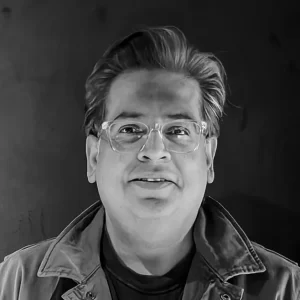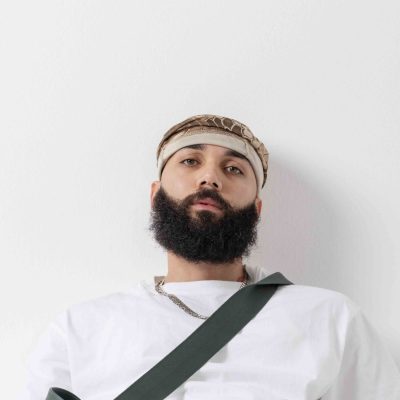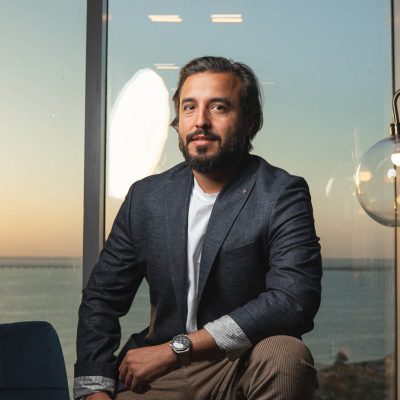Kuwaiti interior designer Abdullah Erhamah’s journey into the design world began with a childhood fascination for colours and sketching. Initially pursuing a different academic path, he soon pivoted towards interior design—a field where he felt truly at home. Before establishing his design career, Abdullah worked as a teacher, a role that shaped his discipline, communication skills, and his unique ability to read people—qualities that now define his approach to client relationships and creative briefs.
In 2018, Abdullah founded Zwaya, meaning “corners” in Arabic, a name reflecting his passion for overlooked details and thoughtful design. His style balances modern minimalism with refined materials, blending simplicity with understated luxury. He designs not for trends, but around lifestyles—an ethos he’s embedded into Zwaya’s process.
His portfolio includes visionary concepts like an Apple Store in the Subiyah desert, cultural monuments, and boutique hotel concepts inspired by Kuwait’s natural landscapes. With ambitions to expand into London and Doha, Zwaya continues to push regional design into global conversations.
Abdullah draws inspiration from everyday life, nature, travel, and even his love for cars and horses—all influencing his design sensibility. For aspiring designers, he emphasises patience, constant learning, and a deep understanding of how people live.
We at CP Magazine thank Abdullah for sharing his journey and vision—an inspiring blend of artistry, purpose, and innovation.
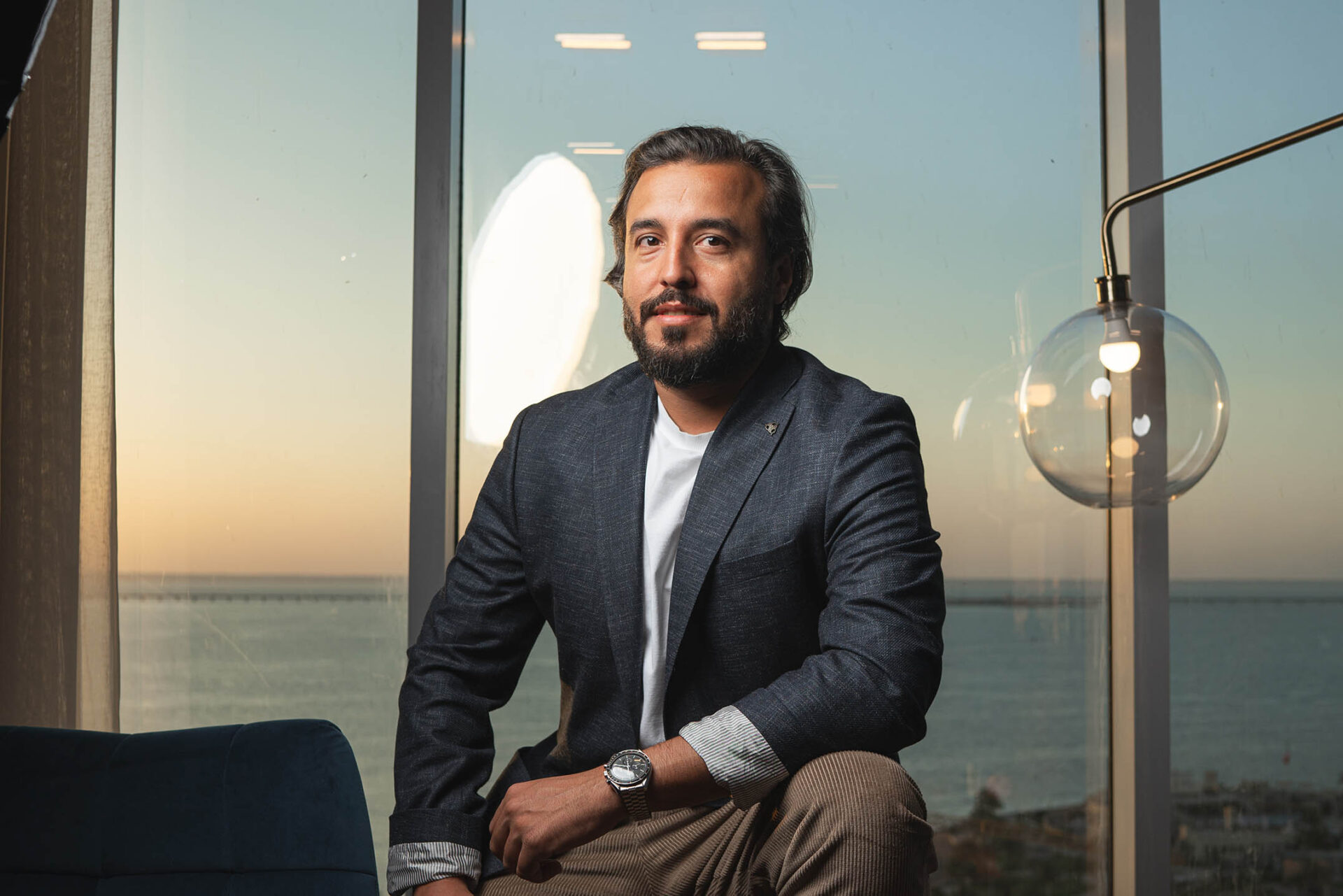
What inspired you to pursue a career in interior design?
Ever since I was a child, I loved colors and drawing. I would spend hours either sketching or arranging things from my imagination. Later on, I started exploring 3D design software—back then the programs were very basic and limited, but even so, I was able to recreate and redesign my own home using them, reimagining the spaces in my own way.
After high school, I enrolled in university and started studying a completely different major. But after two years, I realized that path wasn’t for me. That’s when I decided to switch to interior design—it was the field where I truly felt comfortable and where I could see myself thriving.
Before becoming an interior designer, you were a teacher—what led to that career choice, and how did you transition to design?
Yes, that’s right—I initially worked as a teacher, and it’s an experience I truly value. It taught me discipline, organization, and how to effectively work with people. However, I always felt that it wasn’t the field I wanted to stay in long-term.
Design was always on my mind. I pursued it as a hobby and started experimenting with ideas on a small scale. Over time, I began taking on more design work and handling small projects. Once I felt I had built a solid foundation and developed the necessary skills, I made the decision to leave teaching and dedicate myself fully to interior design.
How did your teaching experience influence your approach to design?
Teaching taught me a lot—first and foremost, commitment, organization, and how to convey information in a clear and simple way. I was always observing what students were drawn to and what captured their attention, which helped me develop the ability to read people quickly.
During my teaching years, I interacted with individuals from various age groups and diverse backgrounds, which exposed me to different segments of society. That experience made me more adaptable and better at understanding different personalities.
All of these skills naturally translated into my work in design. I became able to understand clients from the very first meeting, even when they couldn’t fully express what they wanted. I also developed a calm, effective communication style that made the process much smoother and more transparent.
In short, the teaching experience shaped me on a human level before it did on a professional one.
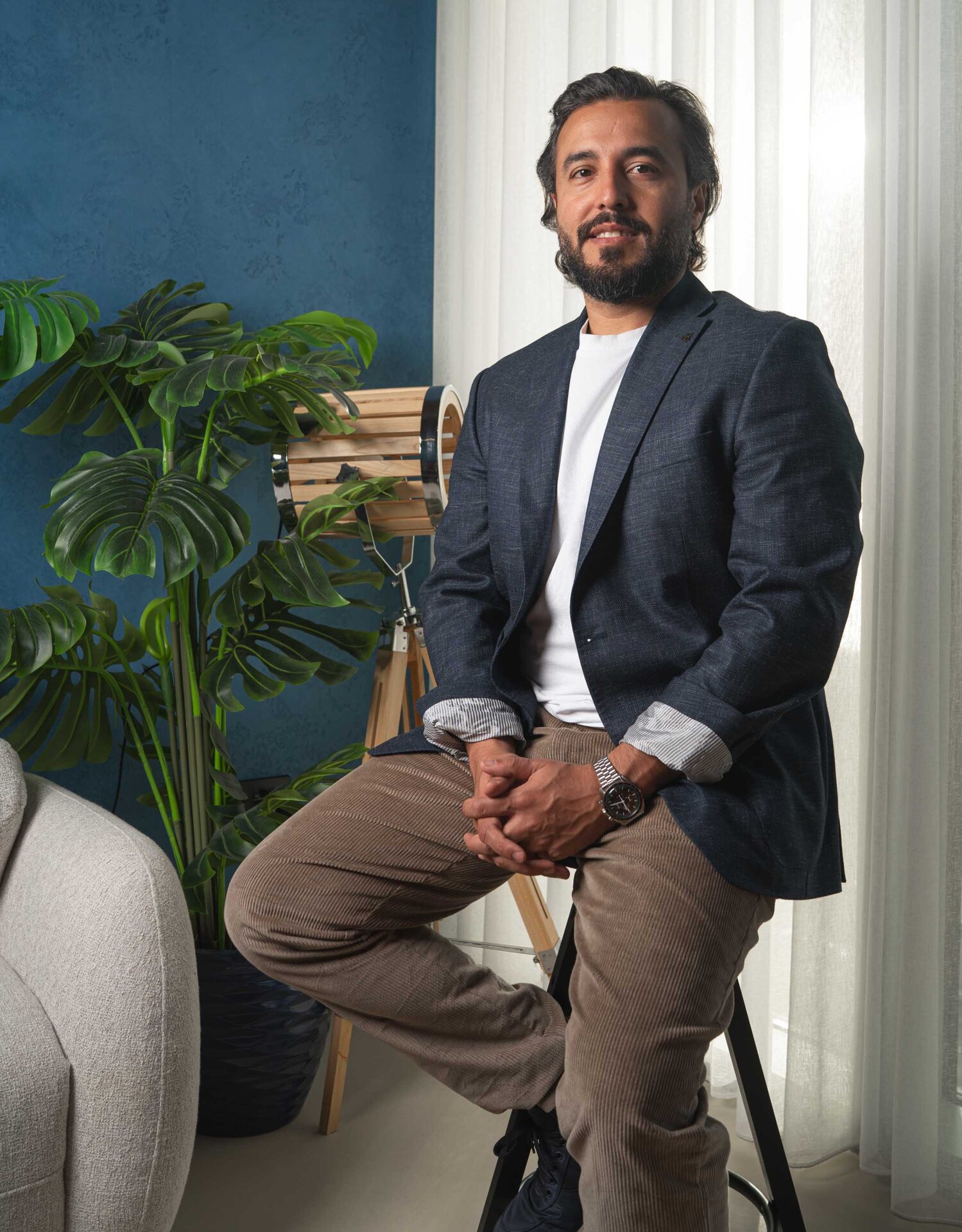
What were the biggest challenges you faced when starting in this field?
My beginnings were quite humble. In university, I only learned the basics, so I had to take it upon myself to grow through courses and self-training. I taught myself how to use design software and kept learning and experimenting until I felt ready to offer something unique.
One of the first challenges I faced was figuring out how to communicate my ideas and designs to others. But with the rise of social media, I gained a platform to showcase my work—especially since my designs stood out and were different from what was commonly seen.
The biggest challenge, however, was my very first real project. That’s where I learned how to truly listen to the client, understand their needs, and design something that reflects their personality. I went through every stage of the project, from concept to execution, and learned how to handle revisions and feedback until the vision came to life.
Who are your biggest influences in the world of design?
There are many designers and architects who have influenced me, each in their own unique way. Among architects, I admire Tadao Ando for his minimalist approach and masterful use of light, Zaha Hadid for her bold and groundbreaking designs, and Norman Foster for his smart and effective integration of technology with simplicity.
In terms of interior designers, I’m particularly drawn to Axel Vervoordt’s style—his focus on emotional comfort and profound simplicity really resonates with me. I also appreciate Erin Gates, who skillfully blends classic taste with a modern, livable style. Jean-Louis Deniot stands out with his luxurious yet warm and elegant designs.
Among Gulf designers, I’m especially proud of the Kuwaiti designer Raed Al-Saifi. His style is distinctive, his work is constantly evolving, and the way he presents interior design has a unique identity that inspires me.
To be honest, it’s not only the well-known names that influence me. Many of my clients and even the simplest of projects have taught me more than any book or course ever could.
How would you describe your signature style?
My design style focuses on modern minimalism, but I like to elevate it with a touch of luxury through the selection of materials and attention to detail. I don’t lean toward clutter or complexity—I prefer spaces that are clean, organized, and visually calming, yet still convey a sense of sophistication through their finishes and materials.
I’m usually drawn to soft colors and natural textures, but I believe every project should have its own unique character. Design isn’t something fixed; it should adapt to the needs and lifestyle of the person living in the space.
That said, I’m always open to working in different styles, because I see design as a collaborative process between the designer and the client.
What do you believe sets your work apart from other designers?
What sets my work apart is my ability to understand the client’s needs—even when they don’t express them directly. Over time, I developed an AI-based digital model that helps identify the client’s taste and requirements through a series of carefully designed questions. It saves a lot of time for both me and the client.
But beyond the tool itself, what really matters is listening—truly understanding how the client lives in their home or space. How they move through it, how they like to spend their time, whether they’re social or prefer privacy, even their financial situation—all of these factors play a major role in how the space should be designed and laid out.
I don’t design based on a ‘style’—I design around a ‘lifestyle.’ And that’s what makes all the difference.
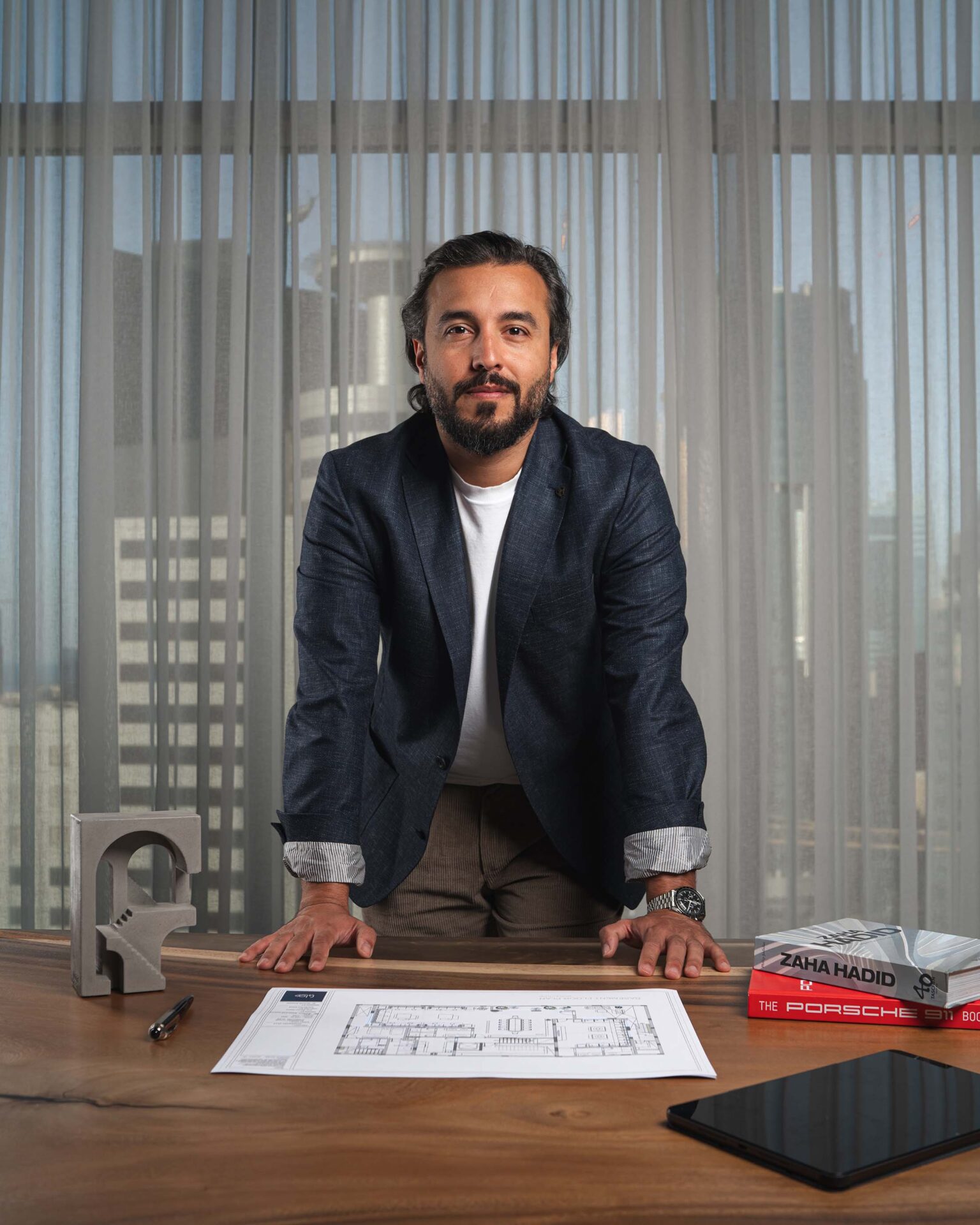
Can you tell us about some of your most memorable projects and why they stand out to you?
I’ve worked on many projects that I’m proud of—some residential, others commercial and governmental. One of the projects I value most was designing a conceptual Apple Store installation in the middle of the Subiyah desert. It was a unique project in both idea and location.
I also worked on designing modern, functional bus stops, as well as a symbolic project—the Martyrs Monument—which expresses national values and history. I developed a full concept for the Mutlaa Airport and contributed to the redevelopment of the zoo in Omariya.
In addition to these, I’ve designed numerous cafés and commercial spaces, along with private residential projects. Each one had its own character and challenges, but the goal has always been the same: to create designs that serve people and reflect their way of living.
When and why did you decide to establish Zwaya?
I founded Zwaya in 2018, after years of working and gaining experience. I felt I had reached a point where I was not only confident in my design skills but also ready to build an entity that could deliver a fully professional, integrated service.
I had noticed that many clients struggled with fragmentation—working separately with a designer, a supplier, and a contractor. That’s where the idea for Zwaya came from: to bring everything under one umbrella, from the initial concept to the final finishing details.
Zwaya is more than just a design office—it’s a mindset. It’s about striking a balance between beauty and functionality, and turning a dream into a real, livable space that reflects the client’s lifestyle and personality.
The name “Zwaya” means “corners”—what’s the story behind choosing this name for your firm?
I chose the name ‘Zwaya’ because it reflects my perspective on details. Corners are often the parts of a space that people overlook, yet they’re what complete the beauty of a place and reveal the precision of the design.
To me, corners represent the meeting point of lines, the intersection of ideas, and the coming together of people within a space. They symbolize the kind of subtle, intentional details that make a real difference—ones that not everyone notices, but everyone feels.
So the name felt like the perfect expression of my work: precise, holistic, and attentive to the smallest detail before the biggest concept.
Do you have a dream project you would love to work on?
Yes, I have several projects that I consider dream projects, each with its own unique character. One of my biggest aspirations is to work on a national project—like a cultural museum or a community center—that reflects Kuwait’s identity and serves as a genuine space for social and cultural interaction. Not just a beautiful building, but a meaningful place with a message and impact.
I’m also passionate about boutique hotel design. I actually developed a full concept for a boutique hotel on Failaka Island and shared it on Instagram. The idea was for the hotel to blend naturally with the island’s landscape and history, offering a luxurious and comfortable experience that still reflects the soul of the place.
Another concept I’ve envisioned is a boutique hotel in a mountainous desert region of Kuwait—a quiet, minimalist retreat with rich details that capture the essence of the Kuwaiti environment in a contemporary way.
To me, these types of projects represent a fusion of local identity and global experience, and that’s the kind of design I love to pursue and hope to bring to life one day.
How do you balance creativity with functionality in your designs?
I always start with the client’s needs and how they intend to use the space, and from there, I develop the creative aspect. I don’t believe that aesthetics should come at the expense of function—or vice versa. To me, a successful design is one that serves you effortlessly in your daily life while also offering a sense of beauty.
I make sure that furniture layout, circulation, lighting, and every detail is carefully thought out. Only then do I move on to selecting materials and colors that give the space its personality.
Sometimes, the creative concept itself is rooted in a functional solution—the design ends up being beautiful precisely because it serves a purpose, not just for the sake of decoration.
Where do you find inspiration for your projects?
Inspiration, for me, comes from the details of everyday life—from the way people live, from small problems a client might mention, or even from a passing experience in a public space. I always try to look at things from a different angle and think about how I can translate them into designs that are functional and lasting.
But when I feel that inspiration is fading or my ideas are starting to repeat themselves, I like to step away from routine and travel somewhere unfamiliar. I disconnect from daily life for a bit and immerse myself in the lives of new people. That exposure to different worlds helps reset my thinking and brings me back with fresh passion and a renewed perspective.
What is your design process like from concept to completion?
I always start by understanding the client and their lifestyle, because design shouldn’t be something pre-made or repetitive. I ask specific questions, observe how they use their space, and sometimes even ask them to share photos from their daily routine so I can form an accurate picture of their needs.
From there, I begin developing the concept, focusing first on space planning and functionality before thinking about colors or furniture. Once we agree on the fundamentals, I build a mood board with materials and color palettes, then move on to 3D modeling to present a full visual of the concept.
After the design is approved, I prepare the execution files and work closely with the implementation teams, following every stage—from infrastructure to the final decorative touches.
I always make sure the client is involved in every step—not just to keep them informed, but so they genuinely feel that the project belongs to them.
Outside of interior design, what are your hobbies and interests?
I love the sea—swimming and fishing in particular—especially when I need to clear my mind. For me, the sea isn’t just a place of relaxation; it’s a constant source of inspiration.
I have a deep passion for cars and engines. I’m drawn to the fine details and the balance between beauty and performance, and that often influences my design aesthetic as well.
I also have a love for horses. I see them as a symbol of elegance, strength, and calm—they’ve taught me focus and patience.
Travel is another passion, especially when it involves new experiences. I enjoy immersing myself in different cultures and meeting people from unfamiliar backgrounds.
Spending time with my family and kids is something I truly value. I love seeing life through their eyes.
And the desert holds a special place in my heart—camping trips and sitting in the middle of nature bring me a sense of peace I can’t find anywhere else.
Do your personal interests influence your design aesthetic?
Absolutely. Every hobby I have influences my design taste in one way or another. For example, my love for the sea draws me toward calm colors and natural materials that create a sense of tranquility.
My passion for cars has made me appreciate fine details and high-quality finishes—whether it’s in a piece of furniture or a lighting fixture. Horses have taught me the balance between strength and elegance, which I try to reflect in spaces that need to feel both formal and warm at the same time.
Travel has broadened my perspective, not just in design styles but in how I think creatively. And every desert trip or quiet moment in nature brings me genuine ideas—not just visuals pulled from the internet.
Simply put, my everyday life shapes my design sense. Every project I work on carries a piece of me.
Do you have a favorite quote or philosophy that guides your work?
I always believe that the greatest failure is not trying—whether in life or in design. You have to take risks, make mistakes, and learn from them.
When it comes to design, I often say: ‘Good design is simple. Failed design is what complicates the user’s life.’
I don’t believe in excess or unnecessary elements. A successful design is one that’s clear, easy, and comfortable—a space that serves its user, not the other way around.
What advice would you give to aspiring interior designers?
My advice to anyone entering the field of interior design is: don’t rush the results, and always stay in learning mode. Design isn’t just about taste—it’s about understanding, analysis, and experience.
Start with small steps and work on simple projects, even if they’re voluntary or for family and friends. These types of experiences are what truly shape you.
Learn the tools and software, and always observe how people live—that’s the foundation of any successful design.
And don’t compare yourself to those ahead of you. Compare yourself to the version you were yesterday—that’s where you’ll see your real growth.
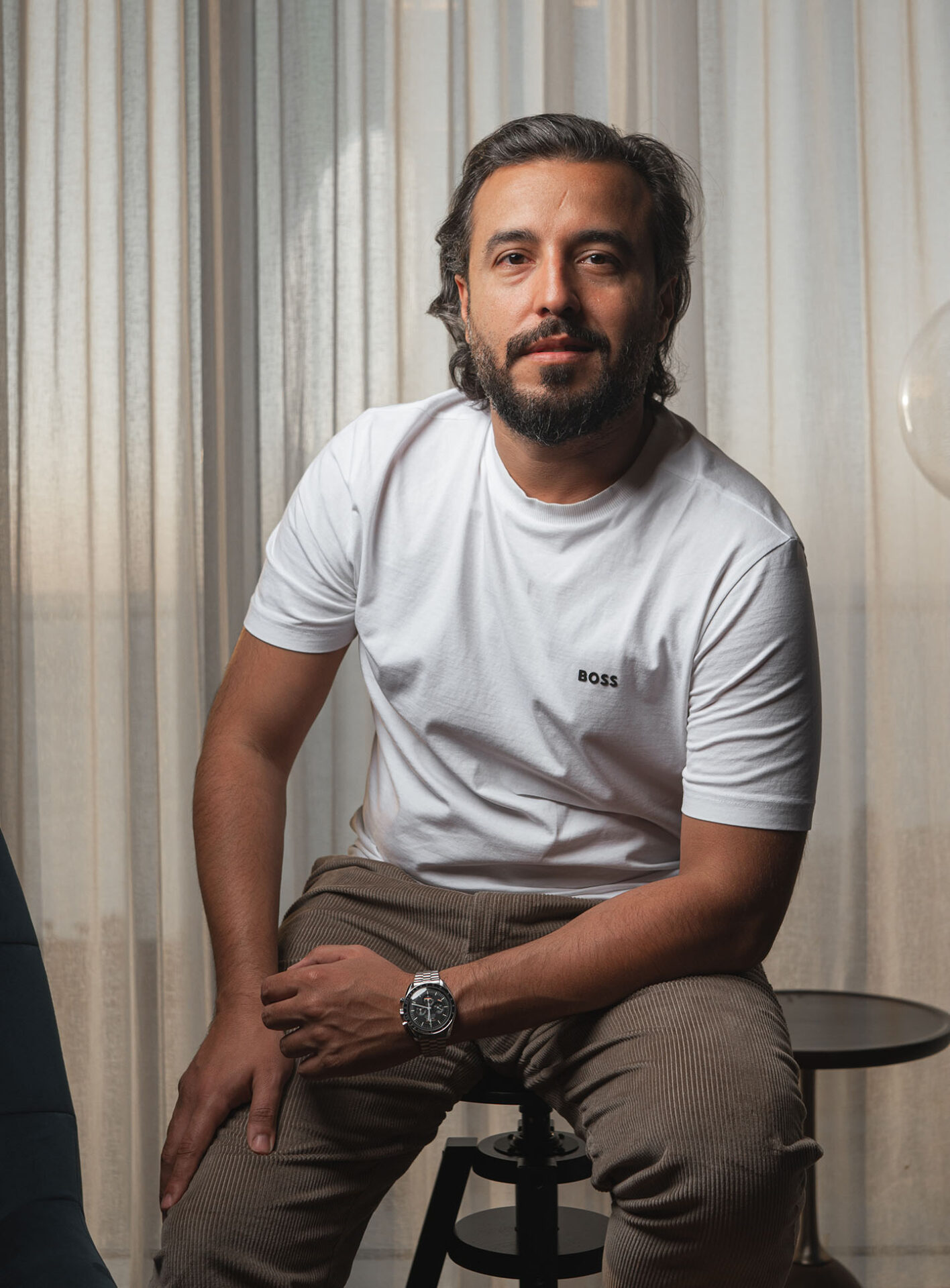
What are your future plans for yourself and Zwaya?
The future plans for Zwaya are ambitious and clearly defined. One of our main goals right now is to open a new branch in Europe—specifically in London—so we can introduce our Gulf design aesthetic to an international audience and foster a kind of cultural exchange in the world of design.
At the same time, we’re working on launching a branch in Doha, Qatar. The market there is promising, and the design taste aligns closely with ours, making it a natural opportunity for expansion.
We’re also focused on enhancing our in-house services at Zwaya by offering more modern, comprehensive solutions—covering everything from the initial concept to the final detail in each space.
One project we’re particularly proud of, and that will be launching soon, is a digital platform that connects users with furniture suppliers and interior design service providers. It’s designed to be a smart tool that makes it easier for people to find practical solutions and removes the hassle of searching and coordination.
If you could design any space in the world, what would it be and why?
I have a dream to design a cultural center that serves as a vibrant heart of the community—a space that brings together art, education, and history, and truly fosters awareness and meaningful connection among people. I want it to be more than just a building; I want it to be a living, communal experience that leaves a lasting impact.
At the same time, I have a deep passion for designing boutique hotels in unique locations—whether it’s an island like Failaka or a mountainous spot in the Kuwaiti desert. I love this type of project because it allows me to blend comfort, identity, and nature, creating an atmosphere where the visitor can live a moment that feels unlike any other.
These types of spaces, to me, are more than just design projects—they’re opportunities to create emotions and details that stay in people’s memories.
Your message for us at CP magazine.
A heartfelt thank you to CP Magazine for this wonderful opportunity—I’m truly honored to be part of this interview.
I’ve been a fan and follower of the magazine for some time now, and I’ve always admired its unique approach and refined focus on the world of design and creativity.
I’d also like to extend my sincere thanks to Mr. Jameel for reaching out and extending the invitation. I consider it a special opportunity to share a part of my journey and experience.
Photography by Yousef Salem


